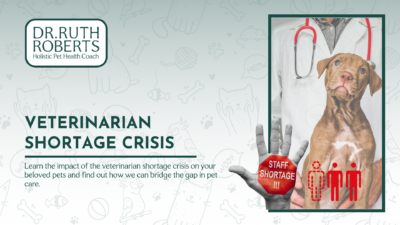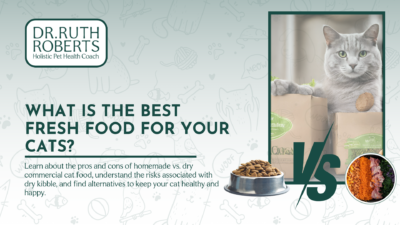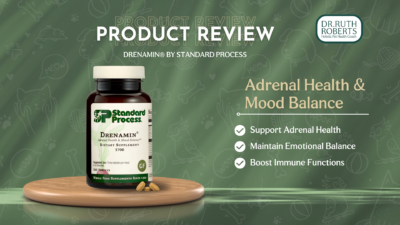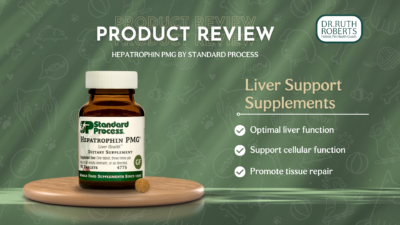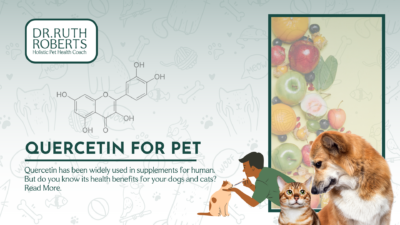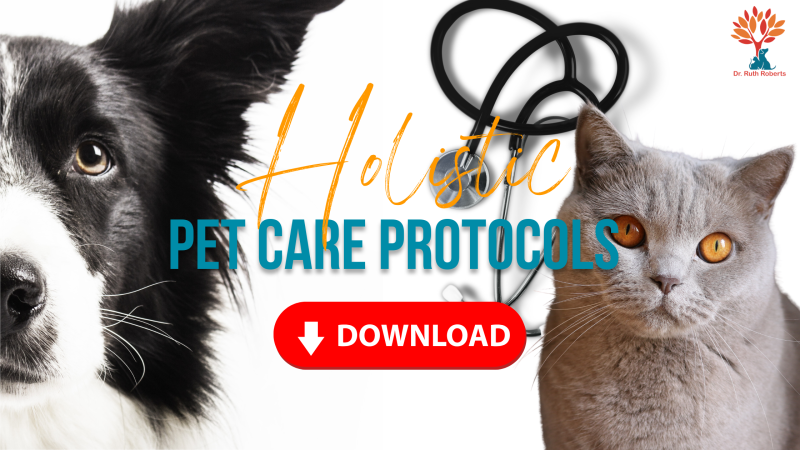Pancreatitis in Dogs
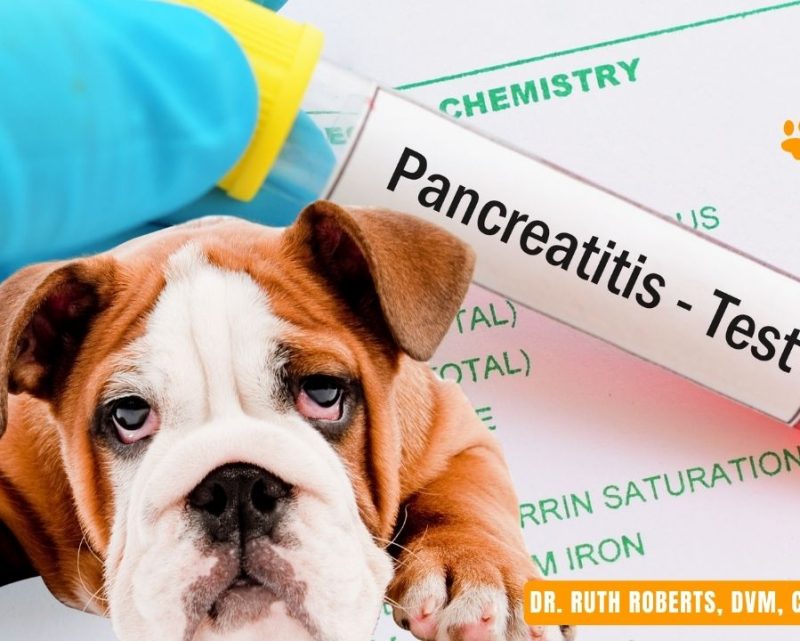
What is up with pancreatitis in dogs? What are the symptoms, the causes, the treatments? It’s like every time your dog gets sick, and is vomiting, and has diarrhea, it has pancreatitis already. So let’s walk through this a little bit. So what can trigger pancreatitis in dogs?
Two Forms of Pancreatitis in Dogs
The Acute Form
There’s vomiting, there’s diarrhea, there’s a lot of abdominal pain. Your dog feels horrible and it’s in the hospital getting fluids. And it’s just really bad. There can be milder versions of these acute attacks. And in this situation, often it is. As your dog has eaten something super fatty. So when I finished veterinary school, we used to call this garbage can disease or Monday morning disease. Everybody would barbecue, a big fat, nice juicy steak on the weekend for the fat and the garbage and the bone and the dog. We’d get into the garbage, eat the fat, the bone, and then boom! Sunday night, they’re throwing up; Monday, they’re at the hospital because the vomiting is just going on. That’s one form that certainly is the way most people will think about it.
The Chronic Form
Now, this can happen. When your pet has had multiple episodes of pancreatitis. And you, it eats any extra fat and boom! It’s got vomiting, it’s got diarrhea. It’s something you figured out how to control so maybe you don’t need to go to the vet. But more often, when I’m seeing this in his dog, work for a living and in specific guide dogs for the blind other assistance dogs, things of this nature or dogs that are just super anxious. They didn’t necessarily ever vomit. They didn’t necessarily ever have diarrhea, although the symptoms could elevate and that could happen, but that was pretty infrequent, really more of what they had was chronic abdominal pain and that’s pretty miserable.
How can I treat my dog's pancreatitis at home?
Pancreatitis in dogs treatment at home in the acute phase often doesn’t go very well, certainly. First of all, want to know what is pancreatitis in dogs’ symptoms and you want to withhold food because the more they eat, the more they vomit. Similarly, don’t leave a giant bowl of water down because if your dog has an upset tummy, they’re dehydrated. They suck a ton of water down.
They’ve vomited right back up. And you can offer small amounts of ice chips throughout the day to help relieve some of that dehydration. But honestly, if your dog has been vomiting every two hours or having diarrhea every two hours, you really need to go to the vet.

Pancreatitis in Dogs Treatment
Now, once you get to the vet, the treatment is really pretty nonspecific and it depends on the severity of the disease that your dog has been experiencing.
- Medication: to help stop the vomiting and help relieve the abdominal pain.
- Fluids: to help rehydrate your pet, whether that’s subcutaneously or under the skin, or intravenously because your pet is really sick and needs to be in the hospital.
- At-home treatments: This gets really risky. But if your pet has had multiple episodes of GI upset, you can talk to your vet about having an at-home treatment kit available with snapping like Cerenia, to help control nausea and vomiting. Maybe an acid reducer, Pepcid or Ondansetron, and then some subQ fluids, because if you can get the vomiting stopped and stop hating your pet, stop taking up the water, then a lot of times you can arrest the symptoms and your dog can recover naturally.
Some other things that you could use once the vomiting is under control would be things like Slippery Elm and other demulcents that will help soothe the gut a bit. And then certainly if you are using essential oils, there’s a product called Di-Gize from Young Living and there are probably other formulas that are similar to that, but I found that to be super effective for controlling sort of minor symptoms if you will.
Now, I keep referring to the fact that the tests for pancreatitis are not all that they are cracked up to be, and it is the truth. So here it is in two different ways. So VCA is a very large chain of veterinary hospitals in the United States and what they’re saying is that the cPLI test has approximately 85% of dogs, very specific for that issue.
That’s 15% of dogs that it doesn’t do anything for. And then if we look at the sort of site from Australia in Queensland, they’re saying it the way it really is. There are no tests that can diagnose pancreatitis with 100% specificity, and it’s therefore easily diagnosed.
This is what I’m saying to you. You go to the vet, and your dog’s vomiting. They give it a cPLI test. “Oh yeah. Your dog has pancreatitis.” “No, maybe it just has gastroenteritis.” Because this is the issue too, is that the symptoms of pancreatitis are really similar to gastroenteritis.
The thing that seems to be a little bit different is that there is a lot more pain typically in the area of the pancreas, but not always. And then, you know, the other thing is that. Here it is again, the most common clinical signs include nausea, vomiting fever, lethargy, abdominal pain, diarrhea, and decreased appetite. But the thing, this is the differentiating thing to me: the prayer position where the downward dog, that means there’s really significant abdominal pain that can go with pancreatitis.
I can also go with obstruction of the GI tract. So this is the problem is that we’ve been conditioned to say any vomiting and diarrhea is pancreatitis when in fact it’s not.
Can a dog recover from pancreatitis?
Absolutely yes. It will need to eat less fat than before. How much? I don’t know! The problem is that we know it needs to eat less fat and maybe it needs to eat better quality of fat. So if you think about it, most pet foods are produced from commercially produced animals and their fat is very high in pro-inflammatory molecules.
So maybe a cleaner vegetable oil, like olive oil, sunflower seed oil, that’s processed properly, things of that nature. A low calorie home-cooked diet, high doses of Omega-3 fatty acids, Turmeric, and Assisi Loop/Lounge to reduce pain and inflammation would be a better bet. The other thing is that your dog’s hand will certainly recover from pancreatitis if that has not happened in a week or so after it got diagnosed. Maybe there’s something else going on and maybe you need some additional studies like X-rays, ultrasound, etc.
Back to what I said earlier about pancreatitis being misdiagnosed, you can have a dog that has a perfectly normal-looking pancreas on ultrasound, but that dog has pancreatitis and the converse is true as well. You can have a very inflamed ugly, damn looking pancreas old herself and the dog doesn’t have pancreatitis. So you really have to be careful about this.
What are the warning signs of pancreatitis?
If you have seen this in your pet before, you know them. “Oh, I don’t feel so good.” “I’m not going to eat.” “Ate a little bit..” and then comes right back up and then it can progress on and on and on. And again, for dogs with chronic pancreatitis, its symptoms and dog symptoms may be very different as far as; “Oh I just don’t feel good.” “My tummy hurts.” “I’m licking my lips.” “I have gas bubbles in my tummy that you can hear.” Those may be the more common symptoms. And for those dogs, often their episodes are triggered by stress and emotional issues within the house. And if they’ve been working at a particular job for a long time, the stress of it may become too much.
So that’s where you’ve got a whole host of other things to work on as far as reducing that symptomatology.
What can I feed my dog who has pancreatitis?
According to conventional veterinary medicine for pancreatitis and dogs, the diet is always the highly processed bag of low-fat prescription food and I’m here to tell you that’s not a great idea either, because again, mostly that food is very pro-inflammatory.
So you want to feed an extremely easy-to-digest food and very anti-inflammatory. So for this reason, and for many dogs that are recovering from gastrointestinal illness in general, starting with a Tunji or almost a porridge.
For many of these dogs, feeding the Tunji or a porridge where you would take a cup of rice, and instead of adding two cups of water to cook it, add four cups. That’s a great place to start. The rice water can actually help to absorb some of the liquid from the intestine if your dog has been experiencing diarrhea.
And then you want basically anything else you’re adding in that may really overcook it and the reason for this is that you were breaking it down so that the food is already pre-digested.
Remember, the pancreas is the organ associated with producing many of our digestive enzymes. So if it is irritated, this is just not a good idea to throw a bunch of raw meat down in there, and then demand that the pancreas produce these enzymes and potentially exacerbate more inflammation and pain in the pancreas.
So that’s super helpful; use things that are going to help control inflammation as well. So things like high doses of Omega-3 fatty acids, and then things like Turmeric if your dog can eat that, but again, take it slowly and gently and intermittent fasting is not a bad way to start.
So if your dog just spent the last three or four days vomiting, feeding it five times a day is not a good plan. Its tummy is not just ready for that. And so you might start literally, with a quarter of what your dog may eat normally volume-wise in a congee in a really easily digested soup and gradually build up over two or three days from there because the last thing we want to do is make that vomiting and that symptomatology worse.
I’m Dr. Ruth Roberts, your pet’s ally.

